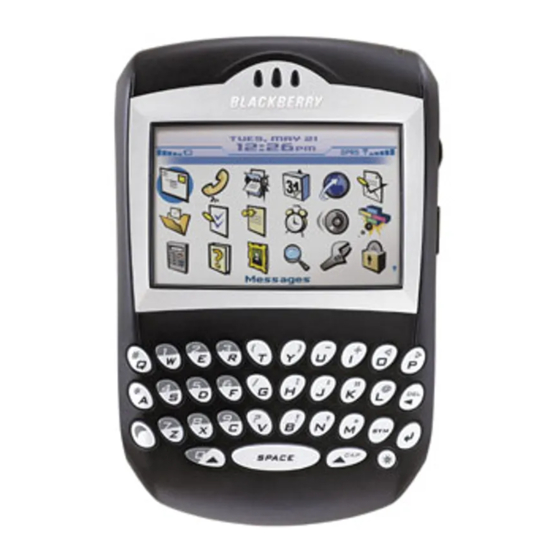Blackberry 7250 - MANUEL 4 Veiligheid en productinformatie - Pagina 7
Blader online of download pdf Veiligheid en productinformatie voor {categorie_naam} Blackberry 7250 - MANUEL 4. Blackberry 7250 - MANUEL 4 10 pagina's. Wireless handheld
Ook voor Blackberry 7250 - MANUEL 4: Aan de slag handleiding (13 pagina's), Handmatig (19 pagina's), Handmatig (12 pagina's), Aan de slag handleiding (27 pagina's)

The highest SAR values for each device model when tested for use at the ear is outlined below:
BlackBerry 7250™
The highest SAR values for each device model when worn on the body, in an approved holster or carrying case, is
outlined below:
BlackBerry 7250™
Body-worn measurements differ among wireless device and phone models, depending upon available accessories and
FCC and IC requirements. While there may be differences between the SAR levels of various wireless devices and at
various positions, they all meet the government requirement for safe exposure.
The FCC has granted an Equipment Authorization for this wireless device model with all reported SAR levels evaluated
as in compliance with the FCC RF emission guidelines. SAR information on this wireless device model is on file with the
FCC and can be found under the Display Grant section of http:// www.fcc.gov/oet/fccid after searching on FCC ID
L6ARAR20CN. Additional information on Specific Absorption Rates (SAR) can be found on the Cellular
Telecommunications & Internet Association (CTIA) web-site at http://www.wow-com.com.
___________________________________
* In the United States and Canada, the SAR limit for mobile devices used by the public is 1.6 watts/kg (W/kg)
averaged over one gram of tissue for the body or head (4.0 W/kg averaged over 10 grams of tissue for the extremities
- hands, wrists, ankles and feet). The standard incorporates a substantial margin of safety to give additional protection
for the public and to account for any variations in measurements.
The long-term characteristics or the possible physiological effects of Radio Frequency Electromagnetic fields have not
been evaluated by Underwriters Laboratories Inc. (UL).
FCC compliance statement (USA)
FCC Class B Part 15
This device complies with Part 15 of the FCC Rules. Operation is subject to the following two conditions:
• This device may not cause harmful interference, and
• This device must accept any interference received, including interference that may cause undesired operation.
Warning: Changes or modifications to this unit not expressly approved by the party responsible for
compliance could void the user's authority to operate this equipment.
This equipment has been tested and found to comply with the limits for a Class B digital device, pursuant to Part 15 of
the FCC Rules. These limits are designed to provide reasonable protection against harmful interference in a residential
installation. This equipment generates, uses and can radiate radio frequency energy and, if not installed and used in
accordance with the manufacturer's instructions, may cause interference harmful to radio communications.
There is no guarantee, however, that interference will not occur in a particular installation. If this equipment does cause
harmful interference to radio or television reception, which can be determined by turning the equipment off and on, the
user is encouraged to try to correct the interference by one or more of the following measures:
• Reorient or relocate the receiving antenna.
• Increase the separation between the equipment and receiver.
• Connect the equipment to an outlet on a circuit different from that to which the receiver is connected.
• Consult the dealer or an experienced radio or TV technician for help.
Device
Device
Safety and Product Information Booklet
1 g SAR (W/kg)
1 g SAR (W/kg)
0.53
0.84
7
